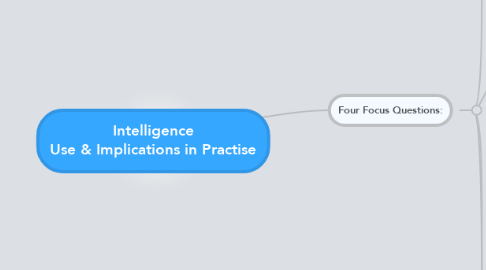
1. Four Focus Questions:
1.1. 1. What is intelligence and why do we care about it as teachers?
1.1.1. Intelligence strong potential to aid education
1.1.1.1. Tailor our teaching to our students
1.1.1.2. Identify the students that require extra support or those that require more of a challenge
1.1.1.3. Helps schools to direct resources and increase entire school performance overall
1.1.1.4. Provide data to assist the government bodies to deliver resources and funds accurately
1.1.2. Definitions of intelligence
1.1.2.1. Varies amongst cultures
1.1.2.2. value-ladden, man-made construct
1.1.2.3. Fixed – born with it and it remains static?
1.1.2.4. Growth – that is grows and changes
1.1.3. Measuring intelligence
1.1.3.1. Intelligence can only be measured indirectly
1.1.3.2. Problems with measuring intelligence: • Over-predict or under-predict abilities • Labelling • Cultural, gender or language differences? • Test anxiety
1.1.3.3. Stanford-Binet, Wechsler Scales
1.1.3.4. The Flynn Effect
1.2. 2. What are the main theories of intelligence?
1.2.1. Charles Spearman: general intelligence or g combines with specific ability to determine performance on mental tasks
1.2.2. Raymond Cattell: crystallized and fluid intelligence
1.2.3. Howard Gardner: theory of multiple intelligences
1.2.4. Robert Stenberg: triarchic theory of intelligence
1.3. 3. Can intelligence measures really affect student learning?
1.3.1. Intelligence used to highlight differences in order to promote inclusive education
1.3.2. Understanding the strengths and weaknesses of our students
1.3.2.1. 1.1: Physical, social and intellectual development and characteristics of students 1.2: Understand how students learn 1.5: Differentiate teaching to meet the specific learning needs of students across the full range of abilities (AITSL, 2012)
1.3.3. Colom & Flores-Mendoza: intelligence scores were the best predictor of academic success, regardless of certain SES factors
1.3.4. Method to prevent disadvantage: e.g. boys versus girls
1.3.5. Problems
1.3.5.1. Locked into a certain definition of success
1.3.5.2. Labelling students
1.3.5.3. Tests anxiety
1.3.5.4. The scores bias our teaching (positive and negative directions)
1.3.5.5. Ignores other impacts on academic achievement (nutrition, culture, stress, coping)
1.4. 4. Can intelligence measures really aid teachers in their practice?
1.4.1. Identify a particular student’s strengths and weaknesses.
1.4.2. IQ results can assist in achieving funding
1.4.3. Method of standardising to promote equality amongst students
